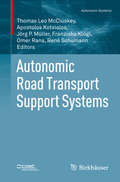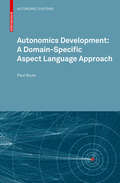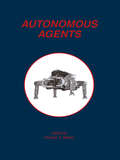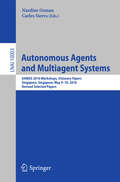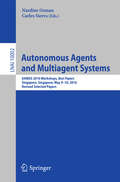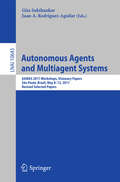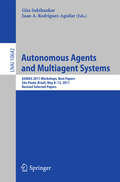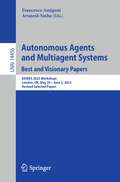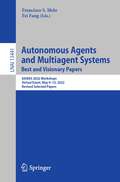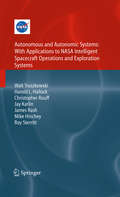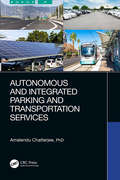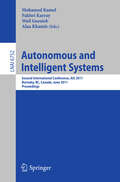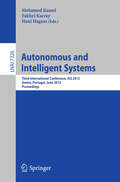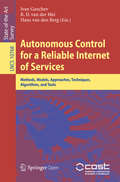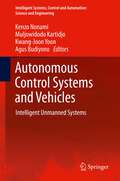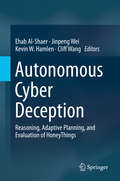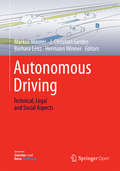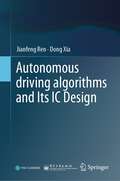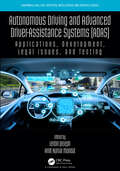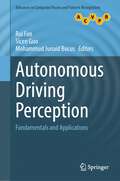- Table View
- List View
Autonomic Road Transport Support Systems (Autonomic Systems #0)
by Thomas Leo McCluskey Apostolos Kotsialos Jörg P. Müller Franziska Klügl Omer Rana René SchumannThe work on Autonomic Road Transport Support (ARTS) presented here aims at meeting the challenge of engineering autonomic behavior in Intelligent Transportation Systems (ITS) by fusing research from the disciplines of traffic engineering and autonomic computing. Ideas and techniques from leading edge artificial intelligence research have been adapted for ITS over the last 30 years. Examples include adaptive control embedded in real time traffic control systems, heuristic algorithms (e.g. in SAT-NAV systems), image processing and computer vision (e.g. in automated surveillance interpretation). Autonomic computing which is inspired from the biological example of the body’s autonomic nervous system is a more recent development. It allows for a more efficient management of heterogeneous distributed computing systems. In the area of computing, autonomic systems are endowed with a number of properties that are generally referred to as self-X properties, including self-configuration, self-healing, self-optimization, self-protection and more generally self-management. Some isolated examples of autonomic properties such as self-adaptation have found their way into ITS technology and have already proved beneficial. This edited volume provides a comprehensive introduction to Autonomic Road Transport Support (ARTS) and describes the development of ARTS systems. It starts out with the visions, opportunities and challenges, then presents the foundations of ARTS and the platforms and methods used and it closes with experiences from real-world applications and prototypes of emerging applications. This makes it suitable for researchers and practitioners in the fields of autonomic computing, traffic and transport management and engineering, AI, and software engineering. Graduate students will benefit from state-of-the-art description, the study of novel methods and the case studies provided.
Autonomics Development: A Domain-Specific Aspect Language Approach (Autonomic Systems)
by Paul SouleDistributed applications are difficult to write as programmers need to adhere to specific distributed systems programming conventions and frameworks, which makes distributed systems development complex and error prone and ties the resultant application to the distributed system because the application's code is tangled with the crosscutting concern distribution. This book introduces the concept of a domain-specific aspect language called a Distribution Definition Language that generalises the distribution and distribution recovery concerns by describing the classes and methods of an existing application to be made remote, the distributed system to use to make them remote and the recovery mechanism to use in the event of an error. A software tool in the form of the RemoteJ compiler/generator that uses information contained in the Distribution Definition Language to generate the recovery and distributed system specific code and apply it to the application using bytecode manipulation and generation techniques is introduced. By allowing distribution and autonomic features, such as recovery, to be modularised and applied to existing applications this approach greatly simplifies distributed systems and autonomics development. This book is of particular interest to researchers and students of distributed systems, autonomics, domain-specific aspect languages and aspect-orientation.
Autonomous Agents
by George BekeyAn agent is a system capable of perceiving the environment, reasoning with the percepts and then acting upon the world. Agents can be purely software systems, in which case their percepts and output `actions' are encoded binary strings. However, agents can also be realized in hardware, and then they are robots. The Artificial Intelligence community frequently views robots as embodied intelligent agents. The First International Conference on Autonomous Agents was held in Santa Monica, California, in February 1997. This conference brought together researchers from around the world with interests in agents, whether implemented purely in software or in hardware. The conference featured such topics as intelligent software agents, agents in virtual environments, agents in the entertainment industry, and robotic agents. Papers on robotic agents were selected for this volume. Autonomous Agents will be of interest to researchers and students in the area of artificial intelligence and robotics.
Autonomous Agents and Multiagent Systems: AAMAS 2016 Workshops, Visionary Papers, Singapore, Singapore, May 9-10, 2016, Revised Selected Papers (Lecture Notes in Computer Science #10003)
by Nardine Osman Carles SierraThis book constitutes the most visionary papers of the AAMAS 2016 Workshops, held in Singapore, Singapore, in May 2016. The 12 revised full papers presented were carefully reviewed and selected from the 12 workshops. They cover specific topics, both theoretical and applied, in the general area of autonomous agents and multiagent systems.
Autonomous Agents and Multiagent Systems: AAMAS 2016 Workshops, Best Papers, Singapore, Singapore, May 9-10, 2016, Revised Selected Papers (Lecture Notes in Computer Science #10002)
by Nardine Osman Carles SierraThis book features a selection of best papers from 11 workshops held at the International Conference on Autonomous Agents and Multiagent Systems, in Singapore in May 2016.The 11 full papers were carefully reviewed and selected for inclusion in this volume. They cover specific topics, both theoretical and applied, in the general area of autonomous agents and multiagent systems.
Autonomous Agents and Multiagent Systems: AAMAS 2017 Workshops, Visionary Papers, São Paulo, Brazil, May 8-12, 2017, Revised Selected Papers (Lecture Notes in Computer Science #10643)
by Gita Sukthankar Juan A. Rodriguez-AguilarThis book compiles the most visionary papers from 10 workshops held at the International Conference on Autonomous Agents and Multiagent Systems, AAMAS 2017, held in Sao Paulo, Brazil, in May 2017. The 15 full papers presented in this volume were carefully reviewed and selected for inclusion in this volume. They deal with novel ideas proposing a change in the way research is currently carried out.
Autonomous Agents and Multiagent Systems: AAMAS 2017 Workshops, Best Papers, São Paulo, Brazil, May 8-12, 2017, Revised Selected Papers (Lecture Notes in Computer Science #10642)
by Gita Sukthankar Juan A. Rodriguez-AguilarThis book features a selection of best papers from 13 workshops held at the International Conference on Autonomous Agents and Multiagent Systems, AAMAS 2017, held in Sao Paulo, Brazil, in May 2017. The 17 full papers presented in this volume were carefully reviewed and selected for inclusion in this volume. They cover specific topics, both theoretical and applied, in the general area of autonomous agents and multiagent systems.
Autonomous Agents and Multiagent Systems. Best and Visionary Papers: AAMAS 2023 Workshops, London, UK, May 29 –June 2, 2023, Revised Selected Papers (Lecture Notes in Computer Science #14456)
by Francesco Amigoni Arunesh SinhaThis book contains visionary and best papers from the workshops held at the International Conference on Autonomous Agents and Multiagent Systems, AAMAS 2023, held in London, UK, during May 29–June 2, 2023.The 12 regular papers, 5 best papers and 7 visionary papers, presented were carefully reviewed and selected from a total of more than 110 contributions to the workshops. They focus on emerging topics and new trends in the area of autonomous agents and multiagent systems and stem from the following workshops:- Workshop on Autonomous Robots and Multirobot Systems (ARMS)- Workshop on Adaptive and Learning Agents (ALA)- Workshop on Interdisciplinary Design of Emotion Sensitive Agents (IDEA)- Workshop on Rebellion and Disobedience in Artificial Intelligence (RaD-AI)- Workshop on Neuro-symbolic AI for Agent and Multi-Agent Systems (NeSyMAS)- Workshop on Multiagent Sequential Decision Making under Uncertainty (MSDM)- Workshop on Citizen-Centric Multi-Agent Systems (C-MAS)
Autonomous Agents and Multiagent Systems. Best and Visionary Papers: AAMAS 2022 Workshops, Virtual Event, May 9–13, 2022, Revised Selected Papers (Lecture Notes in Computer Science #13441)
by Francisco S. Melo Fei FangThis book constitutes thoroughly refereed and revised selected best and visionary papers from the Workshops held at the International Conference on Autonomous Agents and Multiagent Systems AAMAS 2022, which took place online, during May 9–13, 2022.The 5 best papers and 4 visionary papers included in this book stem from the following workshops: - 13th Workshop on Optimization and Learning in Multi-agent Systems (OptLearnMAS);- 23rd Workshop on Multi-Agent Based Simulation (MABS);- 6th Workshop on Agent-Based Modelling of Urban Systems (ABMUS);- 10th Workshop on Engineering Multi-Agent Systems (EMAS);- 1st Workshop on Rebellion and Disobedience in AI (RaD-AI).There was a total of 59 submissions to these workshops.
Autonomous and Autonomic Systems: With Applications To Nasa Intelligent Spacecraft Operations And Exploration Systems (NASA Monographs in Systems and Software Engineering)
by Walt Truszkowski Harold Hallock Christopher Rouff Jay Karlin James Rash Michael Hinchey Roy SterrittIn the early 1990s, NASA Goddard Space Flight Center started researching and developing autonomous and autonomic ground and spacecraft control systems for future NASA missions. This research started by experimenting with and developing expert systems to automate ground station software and reduce the number of people needed to control a spacecraft. This was followed by research into agent-based technology to develop autonomous ground c- trol and spacecraft. Research into this area has now evolved into using the concepts of autonomic systems to make future space missions self-managing and giving them a high degree of survivability in the harsh environments in which they operate. This book describes much of the results of this research. In addition, it aimstodiscusstheneededsoftwaretomakefutureNASAspacemissionsmore completelyautonomousandautonomic.Thecoreofthesoftwareforthesenew missions has been written for other applications or is being applied gradually in current missions, or is in current development. It is intended that this book should document how NASA missions are becoming more autonomous and autonomic and should point to the way of making future missions highly - tonomous and autonomic. What is not covered is the supporting hardware of these missions or the intricate software that implements orbit and at- tude determination, on-board resource allocation, or planning and scheduling (though we refer to these technologies and give references for the interested reader).
Autonomous and Integrated Parking and Transportation Services
by Amalendu ChatterjeeIn this book, the author outlines a Robust Web Parking, Truck and Transportation Portal (RWPTTP) for integrating parking and transportation services – a revolutionary approach in contrast to incremental change for managing traffic congestion. Autonomous vehicle technology, artificial intelligence, internet of things (IOT), and other interconnected hardware and software tools will assist autonomous parking and transportation services and provide next-century infrastructure for consolidated transportation customer services. The book highlights currently available autonomous parking and transportation technologies, and the development of an integrated and intelligent transportation service/system (IITS) platform, with specific use of technologies to reconfigure the transportation industry. The author also suggests many regulatory and policy changes to simplify data collection, traffic operation, introduction of a duplicate transportation system using light rail (LRs) and high speed rail (SPRs), and redistribution of parking spaces along such routes, using renewable energy.
Autonomous and Intelligent Systems: Second International Conference, AIS 2011, Burnaby, BC, Canada, June 22-24, 2011, Proceedings (Lecture Notes in Computer Science #6752)
by Mohamed Kamel Fakhri Karray Wail Gueaieb Alaa KhamisThis book constitutes the refereed proceedings of the Second International Conference on Autonomous and Intelligent Systems, AIS 2011, held in Burnaby, BC, Canada, in June 2011, colocated with the International Conference on Image Analysis and Recognition, IACIAR 2011. The 40 revised full papers presented were carefully reviewed and selected from 62 submissions. The papers are organized in topical sections on autonomous and intelligent systems, intelligent and advanced control systems, intelligent sensing and data analysis, human-machine interaction, and intelligent circuit analysis and signal processing.
Autonomous and Intelligent Systems: Third International Conference, AIS 2012, Aviero, Portugal, June 25-27, 2012, Proceedings (Lecture Notes in Computer Science #7326)
by Mohamed Kamel Fakhri Karray Hani HagrasThis book constitutes the refereed proceedings of the Third International Conference on Autonomous and Intelligent Systems, AIS 2012, held in Aveiro, Portugal, in June 2012, collocated with the International Conference on Image Analysis and Recognition, IACIAR 2012. The 31 revised full papers were carefully reviewed and selected from 48 submissions. The papers are organized in topical sections on autonomous sensors and sensor systems, autonomous systems and intelligent control with applications, intelligent fuzzy systems, intelligent robotics, intelligent knowledge management, swarm and evolutionary methods, and applications
Autonomous Consumer Business
by Julian MorgenEine immer mehr digital vernetzte Welt führt zu einer sehr großen Menge von unterschiedlichen Daten, die in Echtzeit generiert werden („Big Data“). Ein großer Teil dieser Datenproduzenten sind Nutzer von Social Media oder auch smarten Geräten, wie bspw. Fitnesstrackern oder mit dem Internet verbundenen Waschmaschinen („IoT“). Unternehmen, die sich diese Daten aus der direkten Lebenswelt der Konsumenten zu Nutze machen, können sehr präzise Einblicke bspw. über Einstellungen, Verhalten oder auch die Bedürfnisse potenzieller Kunden erhalten, wodurch der Weg zu einer „automatisierten Vermarktung“ geebnet wird. Zielsetzung dieses Buches ist die Entwicklung eines Konzeptes für ein Autonomous Consumer Business (ACB), das als maximal eigenständig agierendes und durch Künstliche Intelligenz getragenes Geschäftsmodell verstanden wird, bei dem Unternehmen die Bedürfnisse auf der Konsumentenseite automatisch erkennen und durch entsprechende Leistungsangebote befriedigen können. Weiterhin werden zentrale Bestimmungsgrößen, welche die konsumentenseitige Inanspruchnahme eines ACB im besonderen Maße beeinflussen, sowie potenzielle Kundengruppen empirisch identifiziert, wodurch Hinweise zur konkreten Ausgestaltung eines ACB gewonnen werden können.
Autonomous Control for a Reliable Internet of Services: Methods, Models, Approaches, Techniques, Algorithms, and Tools (Lecture Notes in Computer Science #10768)
by Ivan Ganchev R. D. van der Mei Hans van den BergThis open access book was prepared as a Final Publication of the COST Action IC1304 “Autonomous Control for a Reliable Internet of Services (ACROSS)”. The book contains 14 chapters and constitutes a show-case of the main outcome of the Action in line with its scientific goals. It will serve as a valuable reference for undergraduate and post-graduate students, educators, faculty members, researchers, engineers, and research strategists working in this field. The explosive growth of the Internet has fundamentally changed the global society. The emergence of concepts like SOA, SaaS, PaaS, IaaS, NaaS, and Cloud Computing in general has catalyzed the migration from the information-oriented Internet into an Internet of Services (IoS). This has opened up virtually unbounded possibilities for the creation of new and innovative services that facilitate business processes and improve the quality of life. However, this also calls for new approaches to ensuring the quality and reliability of these services. The objective of this book is, by applying a systematic approach, to assess the state-of-the-art and consolidate the main research results achieved in this area.
Autonomous Control Systems and Vehicles: Intelligent Unmanned Systems (Intelligent Systems, Control and Automation: Science and Engineering #65)
by Kenzo Nonami, Muljowidodo Kartidjo, Kwang-Joon Yoon and Agus BudiyonoThe International Conference on Intelligent Unmanned Systems 2011 was organized by the International Society of Intelligent Unmanned Systems and locally by the Center for Bio-Micro Robotics Research at Chiba University, Japan. The event was the 7th conference continuing from previous conferences held in Seoul, Korea (2005, 2006), Bali, Indonesia (2007), Nanjing, China (2008), Jeju, Korea (2009), and Bali, Indonesia (2010). ICIUS 2011 focused on both theory and application, primarily covering the topics of robotics, autonomous vehicles, intelligent unmanned technologies, and biomimetics. We invited seven keynote speakers who dealt with related state-of-the-art technologies including unmanned aerial vehicles (UAVs) and micro air vehicles (MAVs), flapping wings (FWs), unmanned ground vehicles (UGVs), underwater vehicles (UVs), bio-inspired robotics, advanced control, and intelligent systems, among others. This book is a collection of excellent papers that were updated after presentation at ICIUS2011. All papers that form the chapters of this book were reviewed and revised from the perspective of advanced relevant technologies in the field. The aim of this book is to stimulate interactions among researchers active in the areas pertinent to intelligent unmanned systems.
Autonomous Cyber Deception: Reasoning, Adaptive Planning, and Evaluation of HoneyThings
by Cliff Wang Ehab Al-Shaer Jinpeng Wei Kevin W. HamlenThis textbook surveys the knowledge base in automated and resilient cyber deception. It features four major parts: cyber deception reasoning frameworks, dynamic decision-making for cyber deception, network-based deception, and malware deception. An important distinguishing characteristic of this book is its inclusion of student exercises at the end of each chapter. Exercises include technical problems, short-answer discussion questions, or hands-on lab exercises, organized at a range of difficulties from easy to advanced,. This is a useful textbook for a wide range of classes and degree levels within the security arena and other related topics. It’s also suitable for researchers and practitioners with a variety of cyber security backgrounds from novice to experienced.
Autonomous Driving: Technical, Legal and Social Aspects
by Markus Maurer J. Christian Gerdes Barbara Lenz Hermann WinnerThis book takes a look at fully automated, autonomous vehicles and discusses many open questions: How can autonomous vehicles be integrated into the current transportation system with diverse users and human drivers? Where do automated vehicles fall under current legal frameworks? What risks are associated with automation and how will society respond to these risks? How will the marketplace react to automated vehicles and what changes may be necessary for companies?Experts from Germany and the United States define key societal, engineering, and mobility issues related to the automation of vehicles. They discuss the decisions programmers of automated vehicles must make to enable vehicles to perceive their environment, interact with other road users, and choose actions that may have ethical consequences. The authors further identify expectations and concerns that will form the basis for individual and societal acceptance of autonomous driving. While the safety benefits of such vehicles are tremendous, the authors demonstrate that these benefits will only be achieved if vehicles have an appropriate safety concept at the heart of their design. Realizing the potential of automated vehicles to reorganize traffic and transform mobility of people and goods requires similar care in the design of vehicles and networks. By covering all of these topics, the book aims to provide a current, comprehensive, and scientifically sound treatment of the emerging field of “autonomous driving".
Autonomous driving algorithms and Its IC Design
by Jianfeng Ren Dong XiaWith the rapid development of artificial intelligence and the emergence of various new sensors, autonomous driving has grown in popularity in recent years. The implementation of autonomous driving requires new sources of sensory data, such as cameras, radars, and lidars, and the algorithm processing requires a high degree of parallel computing. In this regard, traditional CPUs have insufficient computing power, while DSPs are good at image processing but lack sufficient performance for deep learning. Although GPUs are good at training, they are too “power-hungry,” which can affect vehicle performance. Therefore, this book looks to the future, arguing that custom ASICs are bound to become mainstream. With the goal of ICs design for autonomous driving, this book discusses the theory and engineering practice of designing future-oriented autonomous driving SoC chips.The content is divided into thirteen chapters, the first chapter mainly introduces readers to the current challenges and research directions in autonomous driving. Chapters 2–6 focus on algorithm design for perception and planning control. Chapters 7–10 address the optimization of deep learning models and the design of deep learning chips, while Chapters 11-12 cover automatic driving software architecture design. Chapter 13 discusses the 5G application on autonomous drving. This book is suitable for all undergraduates, graduate students, and engineering technicians who are interested in autonomous driving.
Autonomous Driving and Advanced Driver-Assistance Systems: Applications, Development, Legal Issues, and Testing (Chapman & Hall/CRC Artificial Intelligence and Robotics Series)
by Lentin JosephAutonomous Driving and Advanced Driver-Assistance Systems (ADAS): Applications, Development, Legal Issues, and Testing outlines the latest research related to autonomous cars and advanced driver-assistance systems, including the development, testing, and verification for real-time situations of sensor fusion, sensor placement, control algorithms, and computer vision. Features: Co-edited by an experienced roboticist and author and an experienced academic Addresses the legal aspect of autonomous driving and ADAS Presents the application of ADAS in autonomous vehicle parking systems With an infinite number of real-time possibilities that need to be addressed, the methods and the examples included in this book are a valuable source of information for academic and industrial researchers, automotive companies, and suppliers.
Autonomous Driving and Advanced Driver-Assistance Systems: Applications, Development, Legal Issues, and Testing (Chapman & Hall/CRC Artificial Intelligence and Robotics Series)
by Lentin Joseph Amit Kumar MondalAutonomous Driving and Advanced Driver-Assistance Systems (ADAS): Applications, Development, Legal Issues, and Testing outlines the latest research related to autonomous cars and advanced driver-assistance systems, including the development, testing, and verification for real-time situations of sensor fusion, sensor placement, control algorithms, and computer vision. Features: Co-edited by an experienced roboticist and author and an experienced academic Addresses the legal aspect of autonomous driving and ADAS Presents the application of ADAS in autonomous vehicle parking systems With an infinite number of real-time possibilities that need to be addressed, the methods and the examples included in this book are a valuable source of information for academic and industrial researchers, automotive companies, and suppliers.
Autonomous Driving Network: Network Architecture in the Era of Autonomy
by Wenshuan Dang River Huang Yijun Yu Yong ZhangAiming to outline the vision of realizing automated and intelligent communication networks in the era of intelligence, this book describes the development history, application scenarios, theories, architectures, and key technologies of Huawei's Autonomous Driving Network (ADN) solution. In the book, the authors explain the design of the top-level architecture, hierarchical architecture (ANE, NetGraph, and AI Native NE), and key feature architecture (distributed AI and endogenous security) that underpin Huawei's ADN solution. The book delves into various key technologies, including trustworthy AI, distributed AI, digital twin, network simulation, digitization of knowledge and expertise, human-machine symbiosis, NE endogenous intelligence, and endogenous security. It also provides an overview of the standards and level evaluation methods defined by industry and standards organizations, and uses Huawei's ADN solution as an example to illustrate how to implement AN. This book is an essential reference for professionals and researchers who want to gain a deeper understanding of automated and intelligent communication networks and their applications.
Autonomous Driving Network: Network Architecture in the Era of Autonomy
by Wenshuan Dang River Huang Yijun Yu Yong ZhangAiming to outline the vision of realizing automated and intelligent communication networks in the era of intelligence, this book describes the development history, application scenarios, theories, architectures, and key technologies of Huawei's Autonomous Driving Network (ADN) solution. In the book, the authors explain the design of the top-level architecture, hierarchical architecture (ANE, NetGraph, and AI Native NE), and key feature architecture (distributed AI and endogenous security) that underpin Huawei's ADN solution. The book delves into various key technologies, including trustworthy AI, distributed AI, digital twin, network simulation, digitization of knowledge and expertise, human-machine symbiosis, NE endogenous intelligence, and endogenous security. It also provides an overview of the standards and level evaluation methods defined by industry and standards organizations, and uses Huawei's ADN solution as an example to illustrate how to implement AN. This book is an essential reference for professionals and researchers who want to gain a deeper understanding of automated and intelligent communication networks and their applications.
Autonomous Driving Perception: Fundamentals and Applications (Advances in Computer Vision and Pattern Recognition)
by Rui Fan Sicen Guo Mohammud Junaid BocusDiscover the captivating world of computer vision and deep learning for autonomous driving with our comprehensive and in-depth guide. Immerse yourself in an in-depth exploration of cutting-edge topics, carefully crafted to engage tertiary students and ignite the curiosity of researchers and professionals in the field. From fundamental principles to practical applications, this comprehensive guide offers a gentle introduction, expert evaluations of state-of-the-art methods, and inspiring research directions. With a broad range of topics covered, it is also an invaluable resource for university programs offering computer vision and deep learning courses. This book provides clear and simplified algorithm descriptions, making it easy for beginners to understand the complex concepts. We also include carefully selected problems and examples to help reinforce your learning. Don't miss out on this essential guide to computer vision and deep learning for autonomous driving.
Autonomous Dynamic Reconfiguration in Multi-Agent Systems: Improving the Quality and Efficiency of Collaborative Problem Solving (Lecture Notes in Computer Science #2427)
by Markus HannebauerHigh communication efforts and poor problem solving results due to restricted overview are two central issues in collaborative problem solving. This work addresses these issues by introducing the processes of agent melting and agent splitting that enable individual problem solving agents to continually and autonomously reconfigure and adapt themselves to the particular problem to be solved. The author provides a sound theoretical foundation of collaborative problem solving itself and introduces various new design concepts and techniques to improve its quality and efficiency, such as the multi-phase agreement finding protocol for external problem solving, the composable belief-desire-intention agent architecture, and the distribution-aware constraint specification architecture for internal problem solving. The practical relevance and applicability of the concepts and techniques provided are demonstrated by using medical appointment scheduling as a case study.
